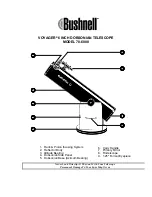
16
If you have not removed the mirror from the mirror cell, be sure to allow the cell to dry completely before returning it to
the telescope. A blow dryer can help speed the drying process. If the secondary mirror is not removed from its cell,
position it during the drying process so the fiberfill in the holder can drain and dry—a minimum of 24 hours is
recommended. If the fiberfill is not completely dry it can drip, leaving water spots on the primary mirror.
Collimating the NGT-12.5
Collimating is the process of aligning the optical components of the telescope for optimum performance. When a
telescope is in need of collimating, you are likely to note that a star in the center of the eyepiece field will not focus
precisely and will appear to be non-circular (elliptical or fan-shaped) when the image is out of focus (i.e. showing a
larger image).
In a Newtonian reflector such as the NGT, there are three components to align: the eyepiece, the secondary mirror,
and the primary mirror. All three must be accurately aligned with respect to each other. Information in this section will
enable the NGT owner to align the secondary and primary mirrors of the telescope.
The (eyepiece) focuser is
permanently set at JMI prior to shipment, and should require no further adjustment.
The NGT is carefully collimated at the factory.
Alignment between the focusing assembly and the diagonal
(secondary mirror) is set to maintain a high degree of accuracy indefinitely, and rarely requires adjustment unless the
focuser and/or diagonal are tampered with or severely jarred. If adjustment does become necessary, it is unlikely that
the axial placement or the tilt of the diagonal will require correction.
The First Step in Collimating—Use of the Sight-Tube
A sight-tube with accurate crosshairs is essential to collimation of a Newtonian reflector. Accurate placement of the
secondary mirror is the first step in collimating and absolutely crucial to the performance of the NGT. In Newtonian
reflectors with fixed focusers, the diagonal (secondary) mirror can be slightly off without dramatically affecting
collimation.
The NGT's rotating nose assembly, however, requires that diagonal mirror placement be exact to
maintain proper collimation—not too high, not too low, with tilt and rotation just right.
The sight -tube is used to
achieve accurate placement of the secondary.
First, adjust axial placement of the secondary by placing the sight-tube in the focuser and moving it in or out until the
outside edge of the secondary mirror is just inside the bottom edge or rim of the sight-tube. The two circular images
should be concentric. If the secondary is high or low, loosen the retaining nut and move the secondary axially (toward
or away from the primary) until concentricity is achieved.
Next, adjust the rotation of the secondary by rotating left or right until the reflection of the primary mirror as seen in the
secondary mirror is perfectly centered left to right. Gently tighten the retaining nut.
Finally, adjust the tilt by loosening one or two of the three screws on top of the secondary mirror cell, and carefully
tightening the opposite one or two. (If you loosen one screw, you must tighten two; if you loosen two, you must
tighten one.) The goal is to adjust the tilt of the secondary such that the bull's-eye, or target, on the primary mirror
appears centered in the crosshairs of the sight-tube. When the secondary is properly adjusted, you will see the
following (as described from the outside of the field of view toward the center).
The rim of the sight-tube.
The outside edge of the secondary mirror, concentric with the rim of the sight-tube all the way round.
The reflection of the primary mirror perfectly centered in the secondary.
The bull's-eye of the primary centered in the crosshairs of the sight-tube.
Summary of Contents for NGT-12.5
Page 2: ......





































